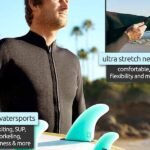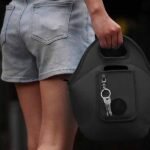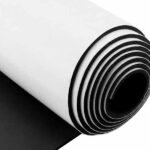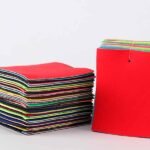A neoprene floating keychain is a lightweight, buoyant key holder made from closed-cell neoprene foam that keeps keys afloat if dropped in water. Its soft, flexible material resists salt, UV, and moisture, making it ideal for boaters, divers, and resort users. Available in many shapes and colors, neoprene key floats can be customized with printed or embossed logos for brands seeking durable, water-safe promotional gear.
You know that sinking feeling when your keys vanish into the lake before you even realize what’s happened? For sailors, jet-ski riders, anglers, and resort guests, losing keys in the water is more than frustrating—it’s expensive. Enter the neoprene floating keychain: a small yet brilliantly engineered piece of foam that turns potential disaster into a gentle bob on the surface.
Unlike metal or hard-plastic keychains, neoprene floats because its closed-cell structure traps millions of microscopic air pockets, giving it natural buoyancy without extra bulk. Wrapped in colorful laminated fabric and finished with stainless-steel rings or carabiners, it combines function, comfort, and branding potential in one compact form.
A neoprene floating keychain keeps your keys from sinking by using buoyant, waterproof neoprene foam that resists water absorption, UV damage, and wear—ideal for marine and outdoor use.
These clever accessories have quietly become staples of marinas, yacht clubs, dive shops, and beach resorts worldwide. For brands, they double as low-cost advertising tools that survive the toughest environments. For end-users, they’re peace of mind on a lanyard.
In the sections ahead, we’ll explore how they’re built, which materials matter, how to test their buoyancy, the design trends driving the market, and how Szoneier, one of China’s most experienced neoprene manufacturers, helps global buyers customize floating keychains that stand out on both water and store shelves.
What Exactly Is a Neoprene Floating Keychain, and How Does It Work?

A neoprene floating keychain is a buoyant accessory made from closed-cell neoprene foam that prevents keys from sinking. Its structure contains tiny sealed air pockets that give natural flotation while repelling water. The soft outer fabric protects against abrasion and UV damage, and the key ring or cord securely attaches to keys. This design keeps small metal items afloat for easy retrieval during boating, diving, or other water activities.
At first glance, a neoprene floating keychain looks like a simple foam charm. But its clever physics make it a small marvel of applied material science.
Neoprene—the same material used in wetsuits—is a closed-cell synthetic rubber (chloroprene) designed to resist water absorption. Unlike open-cell foam, which soaks up moisture, closed-cell neoprene traps countless microscopic gas bubbles within its structure. Each tiny pocket acts like a mini air balloon, allowing the keychain to stay afloat even when carrying several metal keys.
1. Inside the Material: The Science of Floatation
Buoyancy depends on density—the relationship between an object’s mass and the volume of water it displaces. Neoprene’s density averages 0.3–0.6 g/cm³, far lighter than water (1.0 g/cm³). That difference generates positive buoyancy.
| Material | Density (g/cm³) | Floats in Water? |
|---|---|---|
| Aluminum | 2.7 | ❌ |
| Plastic (ABS) | 1.05 | ❌ |
| Neoprene Foam | 0.45 | ✅ |
| Cork | 0.24 | ✅ |
The foam’s closed-cell network prevents water from entering the material even under pressure, ensuring it floats steadily without absorbing weight. This makes neoprene keychains uniquely durable for continuous use in saltwater or freshwater environments.
2. How Construction Affects Performance
A typical neoprene floating keychain features three main layers:
- Inner Core: Neoprene foam sheet (3–5 mm thick) providing buoyancy.
- Outer Lamination: Nylon, polyester, or Lycra fabric for color and strength.
- Hardware Attachment: Stainless steel split ring, carabiner, or short cord loop.
Edges are either heat-sealed or stitched, ensuring no water leakage or foam tearing. This layered design helps achieve an average float capacity of 50–120 grams, depending on thickness and key weight.
Example: A 4 mm neoprene key float can hold 2–3 standard keys; a 6 mm model can float a small electronic fob or car key.
3. Comfort and Ergonomics on the Water
Traditional plastic floats are rigid and sometimes bulky. Neoprene, however, feels soft, flexible, and slightly compressible—making it comfortable in the hand or pocket. Many users also appreciate its temperature neutrality: neoprene doesn’t feel icy in cold weather or sticky under sunlight.
This comfort factor explains why boat rental companies and resorts increasingly prefer neoprene over cork or PVC alternatives. It simply feels premium.
4. Safety and Visibility
Floating keychains don’t just prevent loss—they aid quick visual recovery.
Most are made in bright marine colors (orange, yellow, red, neon green) or even printed with reflective logos. In emergencies, visibility matters; a neon neoprene float is far easier to spot on the surface than a dull plastic tag.
In multi-key use (boats, cabins, jet skis), each color can also represent a category—for instance, red for boat ignition, blue for storage lockers, and yellow for cabin keys—improving organization.
5. Why Neoprene Beats Other Floating Materials
| Property | Neoprene | Cork | EVA Foam | PVC |
|---|---|---|---|---|
| Buoyancy | Excellent | Good | Good | Moderate |
| Durability | High (tear & UV resistant) | Fragile | Moderate | Brittle |
| Comfort | Soft, flexible | Hard | Soft | Hard |
| Branding Surface | Smooth, printable | Rough | Smooth | Glossy |
| Water Resistance | 100% closed-cell | Porous | Semi-closed | Waterproof |
| Lifespan | 3–5 years | 1–2 years | 2–3 years | 2–4 years |
Neoprene’s blend of performance and aesthetics makes it the clear winner for long-term, high-exposure outdoor use.
6. Everyday Scenarios That Prove Its Worth
- Boaters: Drop keys overboard? They float back up within seconds.
- Kayakers: Keeps gear from sinking in case of rollover.
- Resorts: Provides waterproof branded gifts that promote the property year-round.
- Divers and lifeguards: Clips onto wetsuits or buoyancy jackets for easy identification.
One user on a boating forum once joked, “My neoprene keychain has saved me three times—cheaper than marriage counseling!” Humor aside, that’s the core of its appeal: small cost, huge peace of mind.
7. Manufacturing Insight from the Source
Factories like Szoneier manufacture these products using advanced neoprene lamination and die-cutting machines, ensuring uniform buoyancy and shape precision.
Each unit undergoes float testing in water tanks to verify load capacity. For private-label clients, Szoneier offers full customization—from shape cutting (anchor, fish, oval, paddle) to logo printing (silk-screen, heat transfer, or embossed)—allowing brands to merge safety with marketing impact.
Takeaway
A neoprene floating keychain is more than a novelty. It’s a smart, science-backed solution that turns a simple accessory into life-saving practicality.
Understanding how it works helps both users and buyers appreciate why neoprene remains the gold standard for floating key accessories—balancing lightweight design, durability, and branding versatility in one small, floating miracle.
Which Key Features Should You Look for in a Quality Neoprene Floating Keychain?

A high-quality neoprene floating keychain should use thick closed-cell neoprene foam for buoyancy, durable laminated fabric for protection, and corrosion-resistant hardware like stainless steel rings. Key features include strong seams, lightweight comfort, bright visibility, and reliable float capacity (typically 50–120 grams). For brands, customization options—shape, logo printing, color, and packaging—define product quality and appeal in retail or promotional markets.
What Separates a Great Floating Keychain from a Cheap One
All neoprene floating keychains may look similar at first glance—but the real difference lies in details that affect how well they perform and how long they last. Whether you’re a marina retailer, an outdoor brand, or a promotional distributor, understanding what makes one keychain better than another helps you source smarter and build customer trust.
1. Neoprene Quality and Thickness
Neoprene foam is the heart of every floating keychain. Its density, elasticity, and thickness determine buoyancy and durability.
| Specification | Low-Grade | Standard | Premium |
|---|---|---|---|
| Thickness | 2–3 mm | 4–5 mm | 6 mm+ |
| Buoyancy Capacity | 30–60 g | 80–100 g | 120+ g |
| Foam Density | Uneven, soft | Consistent | High resilience |
| Lifespan | < 1 year | 2–3 years | 4–5 years |
Premium keychains use closed-cell CR neoprene (chloroprene) laminated with nylon or polyester jersey on both sides. This combination ensures better resistance to UV exposure, saltwater, and oil.
Lower-cost options might use SBR neoprene or EVA foam, which compresses over time and loses float power.
Pro Tip: Ask your supplier to specify the foam grade (CR or CR/SBR blend) and test buoyancy with real keys. If it barely floats at the surface, the density is too high or the foam has absorbed moisture.
2. Edge Sealing and Construction
Edges are often the weakest point. Poorly sealed or raw-cut edges absorb water and delaminate within months.
Look for these construction standards:
- Heat-sealed or stitched edges with uniform finish.
- Reinforced inner seam to prevent fabric peeling.
- Rounded corners that resist wear and deformation.
Szoneier’s production line, for instance, uses laser cutting to achieve clean, fused edges that stay watertight even under continuous bending—key for long-term buoyancy.
3. Buoyancy Performance
Every keychain’s buoyancy rating tells you how many keys it can safely float.
A good product can handle 50–120 grams (equivalent to 2–4 house keys plus a car remote).
Manufacturers test this by submerging the product in water with standard weights and observing float height after 5 minutes.
| Keychain Type | Neoprene Thickness | Float Capacity | Recommended Use |
|---|---|---|---|
| Compact Oval | 3 mm | 50 g | Hotel or pool keys |
| Boat Float | 5 mm | 100 g | Marine keys |
| Oversized Logo Float | 6 mm+ | 120–150 g | Car keys or gear tags |
4. Hardware and Attachment Design
A floating keychain is only as strong as its connector.
- Stainless Steel Split Rings: Rust-proof, ideal for saltwater.
- Zinc Alloy Rings: Cheaper but may corrode faster.
- Nylon Cord Loops: Lightweight and flexible, good for travel or resort gifts.
- Carabiners or Clips: Useful for attaching to bags, kayaks, or belts.
High-quality manufacturers use marine-grade 304 or 316 stainless steel, ensuring the hardware won’t rust or stain the neoprene fabric.
5. Surface Finish and Branding Potential
The neoprene’s laminated surface offers a perfect canvas for customization:
- Silk Screen Printing – Ideal for bright, simple logos.
- Heat Transfer Printing – Best for multi-color or gradient designs.
- Embossed or Debossed Logos – Adds texture and luxury feel.
- Sublimation Printing – Suitable for photographic or gradient artwork.
Good surface lamination also prevents cracking, fading, and ink bleed.
For resort or event branding, UV-stable inks ensure color longevity even after 12 months of sun exposure.
6. Color and Visibility
Function and design meet here. Bright or neon colors not only look good—they’re critical for visibility on water.
Orange, yellow, red, and lime green are the most visible shades against blue or dark surfaces. Some premium models include reflective strips for night visibility.
If the keychain doubles as a promotional gift, matching corporate colors adds a professional touch.
7. Environmental and Material Safety
As more brands pursue eco-friendly sourcing, check for certifications like:
- OEKO-TEX® Standard 100 (textile safety)
- REACH / RoHS compliance (chemical safety)
- GRS certification (for recycled neoprene options)
Szoneier offers recycled and limestone-based neoprene options that reduce petroleum dependency by up to 30%. This aligns perfectly with sustainability goals in marine and resort industries.
8. Texture, Feel, and User Comfort
Quality neoprene feels smooth, slightly elastic, and soft to touch—not sticky or powdery. The texture should recover after squeezing. This tactile comfort influences customer perception: even as a small item, a soft, well-finished keychain feels more “premium” in hand than a stiff plastic float.
9. Optional Add-ons and Design Enhancements
Today’s floating keychains aren’t limited to simple shapes.
Innovative brands add features such as:
- Integrated mini whistle for safety.
- Carabiner clip + compass combo.
- Double-ring design for better weight distribution.
- Dual-layer foam for added buoyancy with thinner thickness.
These small innovations transform a promotional trinket into a functional lifestyle accessory.
10. Packaging and Presentation
Finally, consider how the product is presented. Branded neoprene floats look more professional in:
- Printed paper sleeves or hang tags.
- PVC zip pouches for waterproof appeal.
- Eco cardboard boxes for sustainable branding.
Well-designed packaging not only protects the item but also reinforces brand perception at retail or trade shows.
How Do You Use a Neoprene Floating Keychain Safely and Effectively?

Attach your keys securely to the neoprene floating keychain using its split ring or cord loop, then test buoyancy in water before use. Avoid overloading—most floats hold 50–120 grams—and rinse with fresh water after exposure to salt. Let it dry naturally in shade. Regular float checks and proper handling ensure your neoprene keychain performs safely during boating, kayaking, diving, or poolside activities.
For such a small accessory, the neoprene floating keychain performs a serious job—keeping your keys from vanishing underwater. Yet, many users don’t realize that using it correctly determines how well it works when it truly matters.
Let’s explore the steps and safety habits that make your key float both reliable and long-lasting.
1. Attach Your Keys Properly
The first and most overlooked step: secure connection.
- Use the stainless-steel split ring or nylon cord loop provided—avoid makeshift clips that might detach.
- Ensure all key holes fit snugly and don’t slide freely.
- If you carry multiple heavy keys, distribute weight between two smaller floats rather than one.
Tip: Before your first trip, hold the assembled keychain in your hand. If it feels overly heavy or unbalanced, it might not float as intended.
2. Test the Buoyancy Before You Trust It
Before heading to the marina or jet ski, fill a sink, bucket, or tub with water and test the float:
- Drop the keychain in gently.
- Observe how much remains above the surface (ideally, at least one-third should stay visible).
- Add or remove keys until you find the optimal balance.
| Key Type | Average Weight | Recommended Float Thickness |
|---|---|---|
| Single house key | 10 g | 3 mm |
| Car key (basic fob) | 40–50 g | 5 mm |
| Boat ignition key + ring | 60–80 g | 6 mm+ |
| Car remote key + extra keys | 90–120 g | Dual float or 6 mm thick |
Testing takes less than a minute and prevents that heart-dropping moment when you realize your key float doesn’t float enough.
3. Know the Limits — Don’t Overload
Every neoprene key float has a maximum buoyant weight.
Once exceeded, it won’t sink instantly—but it will submerge lower and become harder to spot.
Avoid attaching heavy metal tools, bottle openers, or electronic car remotes unless you’ve confirmed float capacity above 100 g.
For larger key sets, use dual floats—one for boat ignition and another for cabin or locker keys. It also minimizes noise and scratching.
4. Use in the Right Conditions
Neoprene floats are made for water, but conditions matter.
- In saltwater: Always rinse afterward to remove salt crystals that degrade fabric and hardware.
- In extreme heat: Keep out of direct sunlight for long periods. Prolonged UV exposure hardens neoprene over time.
- In freezing temperatures: The float stays buoyant, but flexibility decreases—handle gently to avoid cracking.
In tropical climates, a quick rinse and towel dry after every outing maintain elasticity for years.
5. Keep It Visible and Accessible
Visibility is safety. Choose bright, high-contrast colors like neon yellow or orange, especially in murky water.
Attach your float in a spot that’s easy to reach—many boaters clip it to:
- Life vests
- Tackle bags
- Belt loops
- Paddle leashes
That way, even if you fall or capsize, your keys remain with you and visible.
A bright float isn’t just style—it’s recovery insurance.
6. Rinse, Dry, and Maintain After Use
After each trip, do a quick rinse with fresh water, especially after saltwater exposure.
Salt deposits left on metal rings or seams can lead to corrosion and micro-cracking of the laminated surface.
Drying Tips:
- Pat dry with a towel.
- Leave in a shaded, ventilated area—avoid direct heat.
- Store flat or hung to retain shape.
This simple 2-minute care routine extends product life dramatically—one of the reasons resort suppliers prefer neoprene to cork or plastic alternatives.
7. Periodic “Float Check”
Over time, small cuts or foam compression can reduce buoyancy. Perform a float check every 3–6 months:
- Drop it in fresh water without keys first.
- Ensure it floats high and evenly.
- If it tilts or partially submerges, replace or reinforce with a new model.
Many marine equipment brands recommend replacing key floats every 2–3 years of active use for best safety.
8. Keep Branding and Print Safe
If your neoprene keychain includes printed or embossed logos, avoid harsh scrubbing or alcohol-based cleaners.
Simply rinse and air dry. Most premium inks used by factories like Szoneier are UV-cured and salt-resistant, but gentle handling keeps them vibrant longer.
9. Everyday Scenarios: Lessons from the Water
- Scenario 1: A fisherman drops his boat ignition key at the dock—thanks to his neon green neoprene float, it surfaces instantly.
- Scenario 2: A diver keeps spare locker keys clipped to his buoyancy jacket; after hundreds of dives, the neoprene float still performs flawlessly.
- Scenario 3: A resort chain uses custom-printed floating keychains for guest lockers—offering both practicality and subtle brand visibility.
These stories illustrate why the right usage habits transform a $2 accessory into a lifesaving, brand-building product.
10. Quick Dos & Don’ts
| ✅ Do | ❌ Don’t |
|---|---|
| Test buoyancy before each season | Overload with heavy keyrings |
| Rinse with fresh water after salt use | Leave in direct sunlight for hours |
| Use bright colors for visibility | Attach with cheap non-stainless hardware |
| Replace every 2–3 years | Assume all neoprene floats equally |
Are Neoprene Floating Keychains Customizable or Suitable for Private Label/OEM?

Yes. Neoprene floating keychains are highly customizable for OEM and private-label projects. Manufacturers can tailor the shape, size, color, thickness, buoyancy, and logo printing to match brand identity. Options include silk-screen, heat-transfer, or embossed designs, plus eco-friendly materials and packaging. Low minimum order quantities (MOQs), fast sampling, and global shipping make them ideal for promotional, marine, and lifestyle brands seeking durable, branded floating accessories.
Why Customization Defines This Product Category
Unlike ordinary keychains, neoprene floating keychains are equal parts function and branding canvas. Their simple foam form gives wide creative freedom — and when crafted by an experienced factory like Szoneier, they become more than a novelty item.
For brands, the value isn’t just about floatation — it’s about visibility, identity, and trust.
1. Shape and Size Customization
The starting point of OEM development is always shape.
Factories can die-cut neoprene into almost any silhouette imaginable:
- Classic oval and rectangle (most economical)
- Nautical icons like anchors, buoys, fish, paddles, or boats
- Brand mascots or logo outlines for unique recognition
- Functional forms like surfboards, fins, or bottle shapes
Standard sizes range from 80–120 mm in length and 3–6 mm in thickness.
Buoyancy and comfort depend on shape balance — wider floats carry more weight and stay visible from distance.
Tip for buyers: For complex shapes, request 2D or 3D render previews before die-cutting. It prevents wasted sampling rounds.
2. Material Options and Performance Grades
While all floating keychains rely on neoprene’s buoyancy, the foam composition and lamination affect durability and print quality.
| Type | Composition | Float Power | Cost | Typical Use |
|---|---|---|---|---|
| CR Neoprene | 100% Chloroprene | Excellent | Premium | Marine, resort retail |
| CR/SBR Blend | 60/40 mixed foam | Good | Medium | Promotional giveaways |
| Recycled Neoprene | GRS-certified | Good | Eco-line | Sustainable branding |
Outer lamination can be nylon, polyester, or Lycra jersey. Each has unique print feel:
- Nylon = sharp color contrast
- Polyester = durable UV stability
- Lycra = smooth, high-end look
Szoneier uses advanced hot-press lamination to fuse foam and fabric seamlessly — ensuring waterproof bonds and preventing delamination over time.
3. Color and Finishing Flexibility
From bright orange to matte black, neoprene floats can be produced in almost any Pantone color.
For marine applications, vibrant shades like neon yellow, lime, or red are favored for visibility. For retail lines, neutral tones like charcoal or navy pair well with luxury branding.
Color matching is performed using Pantone TPX or C references, ensuring your brand hue is accurately replicated across production batches.
Clients can also choose between:
- Matte or glossy finishes
- Single- or double-sided lamination
- Contrasting edge piping
4. Logo Printing and Branding Techniques
Branding is where neoprene shines. Its smooth laminated surface allows multiple techniques:
| Printing Type | Description | Best For | Durability |
|---|---|---|---|
| Silk Screen | Flat color print | Promotional logos | ★★★★☆ |
| Heat Transfer | Multicolor or gradient artwork | Retail products | ★★★★★ |
| Embossed / Debossed | 3D texture | Premium collections | ★★★★★ |
| Sublimation | Photographic prints | Creative designs | ★★★★☆ |
Logos can appear on one or both sides, and placement near the ring area can be reinforced with fabric backing to prevent tearing.
5. Hardware Customization
Beyond the foam, hardware choices affect both aesthetics and function.
- Rings: 304 or 316 stainless steel (marine-grade), or zinc alloy for budget lines.
- Connectors: Short rope loop, paracord, elastic cord, or detachable clip.
- Accessories: Optional whistle, compass, or key tag label.
For resorts and rental operations, detachable lanyard versions with branding on both key float and neck strap are popular.
6. Packaging and Retail Readiness
A well-presented floating keychain transforms from a giveaway into a desirable product.
Szoneier’s OEM services include packaging options like:
- PVC zipper bags (waterproof visibility)
- Card sleeves with brand story
- Kraft or eco paper boxes for sustainable image
- Custom barcode labels / FBA-ready packaging
Many global buyers request retail-ready packaging directly from factory, reducing post-production handling costs.
7. MOQ and Sampling Advantages
One major advantage of neoprene products is flexible minimum order quantity.
Unlike molded plastic, no expensive tooling is required — designs are die-cut directly from sheets.
| Item Type | Typical MOQ | Sample Lead Time | Bulk Lead Time |
|---|---|---|---|
| Standard Shapes | 200 pcs | 7–10 days | 15–20 days |
| Custom Shapes | 300–500 pcs | 10–14 days | 20–25 days |
| Private Label Retail Pack | 500 pcs | 12–15 days | 25–30 days |
This agility allows even small brands to launch promotional campaigns or test new markets without heavy upfront investment.
8. Eco-Friendly and Premium Options
With environmental awareness rising, Szoneier offers bio-limestone neoprene (non-petroleum based) and recycled fabric laminations (rPET).
These sustainable alternatives maintain identical performance but align with eco-conscious branding — a powerful story for outdoor or marine companies marketing sustainability.
For premium collections, metallic logos, woven tags, or laser-engraved stainless rings add high-end appeal while maintaining buoyancy.
9. Quality Control and Compliance
Each OEM order undergoes strict QC checks:
- Dimensional consistency (±0.5 mm tolerance)
- Float test for every batch (tested in water tanks for 5 minutes)
- Adhesion strength of print and lamination
- Corrosion testing for hardware
Compliance certificates such as REACH, RoHS, and OEKO-TEX 100 are available upon request — crucial for importers in the US and EU.
10. Real-World OEM Use Cases
- Resorts & Hotels: Custom logo floats double as room key holders and souvenirs.
- Boat Rental Companies: Durable branded keychains prevent lost ignition keys.
- Outdoor Lifestyle Brands: Sell them as water-sport essentials.
- Corporate Events: Promotional giveaways that are functional and memorable.
Example: A Caribbean resort ordered 5,000 yellow anchor-shaped keychains with embossed branding. The floats not only reduced lost keys by 90% but became popular take-home souvenirs — a small investment with high brand recall.
What Design Styles and Innovations Are Trending in Neoprene Floating Keychains?
The latest trends in neoprene floating keychains focus on creative shapes, eco-friendly materials, multifunctional designs, and vibrant customization. Popular styles include nautical icons like anchors or surfboards, recycled or limestone neoprene for sustainability, and dual-purpose keychains that combine floats with whistles or bottle openers. Bold colors, textured prints, and 3D embossing are in demand among brands seeking eye-catching, functional promotional items that stand out on water and at retail.
Floating keychains have evolved far beyond simple foam ovals. Today, they represent a fusion of lifestyle, identity, and innovation—especially for brands targeting marine, outdoor, and resort markets.
Let’s dive into the most exciting design directions shaping this humble yet powerful product in 2025.
1. Iconic Nautical Shapes — From Utility to Storytelling
The most recognizable floating keychains borrow their forms from the sea.
Classic shapes like anchors, buoys, fish, surfboards, and paddles instantly connect with marine culture.
These silhouettes not only reinforce function (a float for water gear) but also communicate mood and brand personality.
| Shape | Symbolism | Target Market |
|---|---|---|
| Anchor | Stability, trust | Marinas, boat rental services |
| Surfboard | Adventure, youth | Water-sport brands, surf schools |
| Fish | Fun, leisure | Resorts, gift shops |
| Paddle | Strength, endurance | Kayak & canoe clubs |
| Life Buoy | Safety, reliability | Marine equipment suppliers |
Some brands go further, shaping the keychain to resemble their company logo or mascot, creating instant visual recall in the user’s hand or pocket.
“We realized guests take these home as souvenirs,” a Caribbean resort buyer told Szoneier. “So now our floats are shaped like mini surfboards—with our beach logo embossed.”
2. Eco-Friendly & Sustainable Materials
As sustainability becomes a non-negotiable factor, the floating keychain industry has embraced green neoprene innovations:
- Recycled Neoprene Foam: Derived from post-production or post-consumer scraps.
- Bio-Limestone Neoprene: Made from natural calcium carbonate instead of petroleum.
- rPET Fabric Lamination: Uses recycled plastic bottles as outer fabric layers.
| Eco Option | Key Benefit | Environmental Impact |
|---|---|---|
| Recycled Neoprene | Reduces waste | Diverts landfill scraps |
| Limestone Neoprene | Renewable input | Cuts petroleum use 30%+ |
| rPET Fabric | Circular economy | Reuses plastic bottles |
These sustainable options don’t sacrifice performance—they still float, resist salt, and print beautifully.
Brands can even highlight eco-materials in product packaging or hang tags, appealing to environmentally conscious consumers.
3. Multifunctional Floating Accessories
Modern buyers expect versatility. Manufacturers like Szoneier now offer multi-feature neoprene floats that go beyond just holding keys:
- Whistle + Float Combo: Ideal for kayaking and safety gear.
- Bottle Opener + Float: Perfect for resorts, bars, and events.
- Mini Dry Pouch Float: Stores coins or small items.
- Float + Lanyard Set: Combines wrist strap comfort with visibility.
These hybrid designs transform a $2 item into a multifunctional “micro-tool” that customers genuinely value and keep—boosting long-term brand exposure.
4. Bold Colors & Textured Finishes
Color isn’t just aesthetic—it’s a survival feature on water.
Bright orange, neon yellow, and vivid blue remain staples for marine visibility. Yet brands are also experimenting with dual-tone laminations and gradient color fades that echo surf and beach culture.
Advanced printing allows for creative surface effects:
- Matte + Gloss Hybrid Coating for contrast.
- 3D Embossed Logos that add tactile luxury.
- Sublimated Graphics for photographic detail (e.g., coral patterns, waves).
According to Szoneier’s export data, 60% of 2024 neoprene keychain orders included custom dual-color or printed textures—a clear shift toward personalization as a design differentiator.
5. Miniaturized Custom Shapes for Branding
Compact “pocket-sized storytelling” is trending.
Small, intricate cuts shaped like a brand’s product—for example, a surf brand using a surfboard, or a beverage company using a bottle silhouette—create instant emotional connection.
For OEM buyers, these miniaturized designs are achievable without expensive tooling since neoprene sheets are CNC or die-cut directly. This makes personalization affordable even at low MOQs (200–300 pcs).
Example: A European beer brand commissioned bottle-shaped floating keychains as summer promotional giveaways. The campaign generated 25% higher recall than previous flat-logo gifts, according to post-event surveys.
6. Premium Retail Design: Beyond Promotional
Luxury outdoor brands are turning neoprene floats into retail accessories, not just giveaways.
These include:
- Embossed metallic foil logos.
- Reinforced stitching and thicker edge piping.
- Custom hardware like black-nickel carabiners.
- Minimalist monochrome palettes for a premium aesthetic.
Such upgrades allow retailers to sell them for $9–15 retail, compared to typical $2–3 promotional value. It’s proof that thoughtful design can lift even the simplest utility product into a lifestyle accessory.
7. Smart Tech Integrations
Although still niche, some R&D projects are exploring smart chip or NFC tagging inside neoprene floats—allowing owners to register lost keys or link to digital IDs via smartphone tap.
While not mainstream yet, this fusion of IoT + water gear is an emerging category.
Szoneier’s R&D department has experimented with heat-sealed neoprene layers embedding RFID discs that remain waterproof up to 10 meters—an innovation to watch.
8. Packaging as Design Extension
Floating keychains today often come in stylish eco-kraft boxes, resealable pouches, or branded zip bags. The packaging design mirrors the aesthetic of the product—clean, vibrant, and eco-forward.
This enhances shelf appeal for retail buyers and online listings, especially on Amazon or FBA programs where visual presentation drives conversion.
9. Cultural and Seasonal Themes
Customization now extends to seasonal collections—holiday editions, national flags, tropical prints, or event-themed colorways.
For example, dive shops may offer coral reef patterns, while sailing events feature navy stripes or regatta logos.
This rotation model keeps SKUs fresh and encourages repeat seasonal orders, which is key for distributors and wholesalers.
How Do You Care for and Maintain Your Neoprene Floating Keychain to Maximize Its Lifespan?

To maintain a neoprene floating keychain, rinse it with fresh water after salt or chlorine exposure, let it air dry in shade, and store it flat to avoid foam compression. Avoid direct sunlight, chemical cleaners, or overloading with heavy keys. With simple care—rinsing, drying, and seasonal float checks—a quality neoprene keychain can stay buoyant and bright for 3–5 years, keeping your keys secure and your brand logo looking fresh.
Even the toughest neoprene products eventually show wear—but with proper care, you can stretch their lifespan by years.
Most keychain failures happen not from age, but from neglect—salt buildup, UV degradation, or over-compression in storage.
Whether you’re a casual boater, a resort operator, or a brand manager handling large OEM orders, here’s how to keep your neoprene floating keychains looking and performing their best.
1. Rinse After Every Use
After exposure to saltwater, chlorine, or sunscreen, rinse the neoprene with fresh water.
Why it matters:
- Salt crystals can form in the fabric texture, stiffening the surface.
- Chlorine and sunscreen chemicals slowly break down the laminated coating.
- Metal rings may corrode if salt residue stays trapped under seams.
Simple Routine:
- Swish it in a bowl or bucket of clean water for 30 seconds.
- Gently squeeze (don’t wring) the foam to release trapped saltwater.
- Towel dry lightly.
| Exposure Type | Risk | Recommended Rinse Time |
|---|---|---|
| Saltwater | Corrosion, stiffness | 30–60 sec |
| Pool chlorine | Color fading | 60 sec |
| Sand or mud | Abrasion | 1–2 min |
| Sunscreen oils | Surface film | 1–2 min |
2. Dry Naturally in Shade
Never use a dryer, heater, or direct sunlight to dry neoprene.
Excessive heat can cause delamination—where the fabric separates from the foam core.
Instead:
- Hang the keychain on a hook or line in a ventilated area.
- Rotate occasionally so both sides dry evenly.
- Avoid compressing the foam while drying.
Pro Tip: Constant exposure to 50°C+ (e.g., in a hot car) can deform neoprene permanently in just a few days.
3. Store It Flat or Hanging
Long-term compression is one of the silent killers of buoyancy.
If you stack heavy objects on neoprene floats, the foam cells collapse and lose their trapped air, reducing flotation efficiency.
Store your keychains:
- Flat on a shelf or tray (no stacking above 10 pieces).
- Hanging from their metal rings on a hook panel.
- Away from oil, gasoline, or rubber fumes (which can soften neoprene).
For large OEM shipments, factories like Szoneier use vacuum-sealed polybags with air holes to prevent shape deformation during transit.
4. Avoid Harsh Chemicals
Skip strong cleaning agents like alcohol, bleach, or detergent.
They attack both the foam and lamination glue. Instead, use mild soap or baby shampoo.
A soft cloth or sponge is enough for surface cleaning.
| Cleaner Type | Safe for Neoprene? | Comment |
|---|---|---|
| Mild soap | ✅ | Ideal for general cleaning |
| Alcohol-based | ❌ | Weakens adhesive bonds |
| Bleach | ❌ | Causes discoloration |
| Solvent cleaner | ❌ | Destroys foam texture |
5. Handle Hardware with Care
Most floating keychains use stainless-steel or zinc-alloy rings. While stainless resists corrosion, zinc can tarnish in salt air.
Regularly check the ring or clip:
- Tighten loose split rings.
- Replace rusted ones immediately.
- Use marine-grade rings (304 or 316) for coastal use.
Szoneier offers optional anti-rust coatings and nylon loops for long-term outdoor exposure—ideal for marine equipment suppliers.
6. Perform Regular Float Tests
Foam gradually compresses with use. A float test every 3–6 months confirms safety:
- Drop your keychain (with keys attached) into a bucket of water.
- Observe the float level.
- If it dips below halfway, replace it.
- If it tilts or doesn’t rise evenly, inspect seams or foam for micro-cracks.
Most premium neoprene keychains maintain >90% buoyancy even after 2 years of regular use—thanks to closed-cell foam integrity.
7. Protect the Printed or Embossed Logo
If your keychain carries branding, that print is part of its value.
- Rinse gently; never scrub logos.
- Pat dry, don’t rub.
- Avoid strong UV light to preserve colors.
High-quality factories like Szoneier use UV-stable inks and heat-transfer printing, which last up to 1,000 hours of sunlight exposure without fading. Still, indoor storage doubles its longevity.
8. Watch for Signs of Wear
Knowing when to replace is part of maintenance.
Replace your neoprene float if you notice:
- Peeling lamination
- Cracked foam or deformed shape
- Reduced buoyancy or waterlogging
- Rusted or loose hardware
Average lifespan by quality tier:
| Quality Tier | Expected Lifespan | Example |
|---|---|---|
| Economy (SBR blend) | 1–2 years | Promotional giveaway |
| Standard (CR blend) | 2–3 years | Resort or rental use |
| Premium (100% CR) | 3–5 years | Retail-grade keychain |
9. Bulk Buyers: Maintenance as Brand Strategy
For resorts, rental fleets, or OEM clients, maintenance protocols are part of customer experience.
Many businesses replace floats every 2–3 years not because they fail, but to keep branding fresh.
Szoneier helps such buyers with scheduled reorder programs and archived print files to ensure exact logo color and shape continuity over time.
This proactive approach boosts brand consistency—your guests see the same bright, clean key float every season.
10. Sustainability Through Longevity
A well-cared-for neoprene keychain doesn’t just save you replacement costs; it also reduces waste.
Keeping your floats in use longer means fewer discarded materials and lower carbon footprint.
Pairing that with recycled neoprene materials turns a small accessory into a statement of sustainable design—a selling point for eco-conscious brands worldwide.
Conclusion — Keep Your Brand Afloat with the Power of Neoprene

The next time you drop your keys into the water and watch them float gently back to the surface, remember—it’s not just foam keeping them up. It’s engineering, design, and brand trust.
The humble neoprene floating keychain embodies everything modern buyers expect: functionality, comfort, sustainability, and personalization.
In short: neoprene floating keychains combine lightweight buoyancy, high-end durability, and endless customization—making them the superior choice for marine, outdoor, and promotional markets worldwide.
For individual users, it’s about peace of mind.
For brands, it’s about visibility that doesn’t sink.
And for sourcing managers, it’s about choosing a partner who understands both performance and presentation.
Why Szoneier Is the Partner Behind Reliable Neoprene Manufacturing
Behind every floating keychain that performs flawlessly lies a manufacturer who understands the material down to its molecular level.
That’s where Szoneier stands apart.
With over 18 years of neoprene R&D, manufacturing, and export experience, Szoneier has mastered every stage of production—from foam compounding and lamination to printing, die-cutting, and assembly.
Factories in Guangdong integrate advanced equipment for:
- Precision cutting ensuring shape consistency ±0.5 mm
- Closed-cell lamination for waterproof durability
- Heat-seal finishing preventing delamination
- Custom logo application via silk screen, sublimation, or embossing
- 100% float testing before packaging
Each piece that leaves the line is tested, certified, and engineered to perform as promised—whether it’s bobbing in a marina or displayed in a boutique.
What You Gain When Partnering with Szoneier
| Advantage | What It Means for You |
|---|---|
| Free Design & Sampling | Get prototypes in 7–10 days before mass production. |
| Low MOQ Customization | Start from as few as 200 pcs—perfect for boutique or seasonal lines. |
| Certified Materials | OEKO-TEX®, REACH, and RoHS compliance for EU/US import. |
| Fast Turnaround | 15–25 day bulk lead time with global logistics options (FBA, CIF, DDP). |
| OEM / ODM Support | Private-label service with custom packaging and barcoding. |
From small promotional runs to global retail rollouts, Szoneier ensures your neoprene products float your brand higher.
Sustainability That Doesn’t Sink
In 2025, eco-conscious sourcing isn’t optional—it’s expected.
Szoneier leads with limestone-based neoprene and recycled rPET fabric laminations, cutting petroleum dependence by up to 30 %.
Each design proves that sustainability and performance can co-exist—cleaner materials, same buoyant protection.
This commitment helps brands meet ESG goals while maintaining quality their customers can feel and trust.
Global Reliability, Local Support
With global shipping capabilities and overseas FBA nodes, Szoneier delivers fast and seamlessly:
- USA Warehouse: Rapid resupply for Amazon or wholesale.
- Canada, UK, and Germany Nodes: Shorter lead times for EU / NA clients.
- Multilingual Support: English, German, French, and Mandarin service for smooth communication.
Wherever your customers are, your neoprene products arrive on time—ready to perform.











